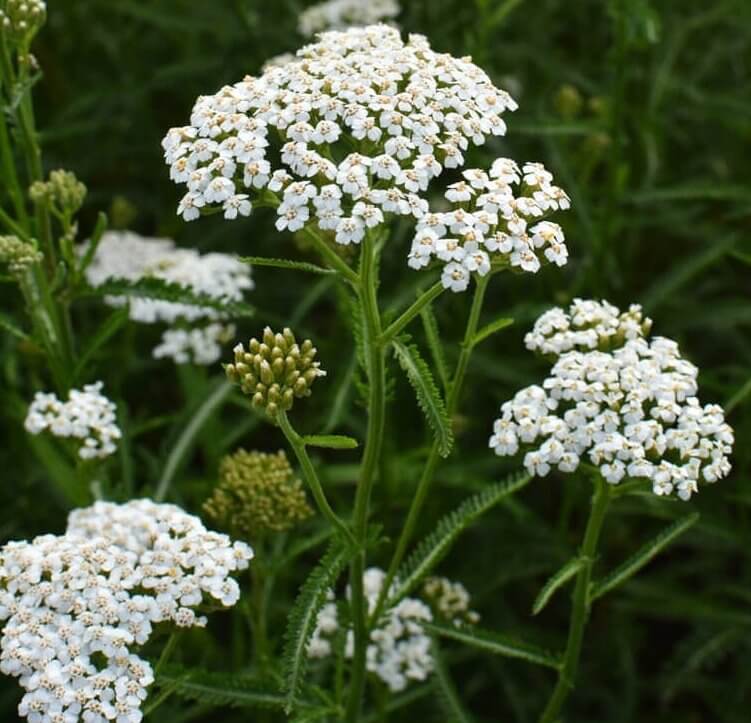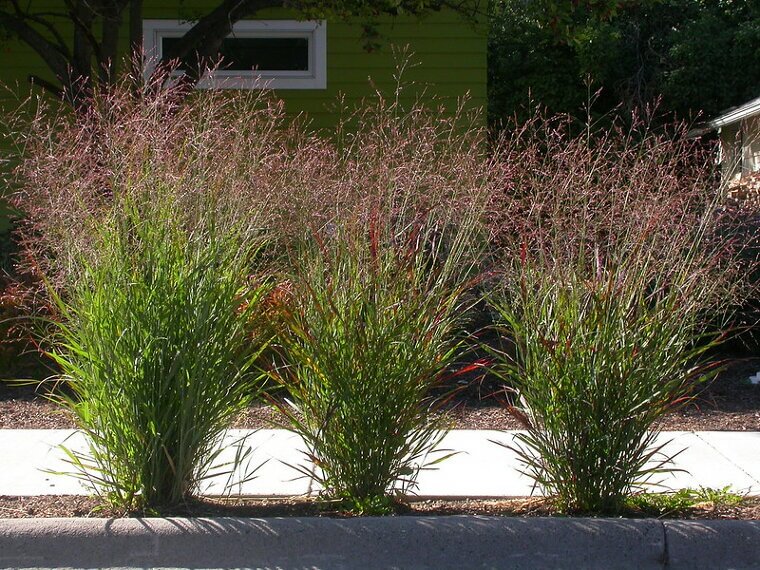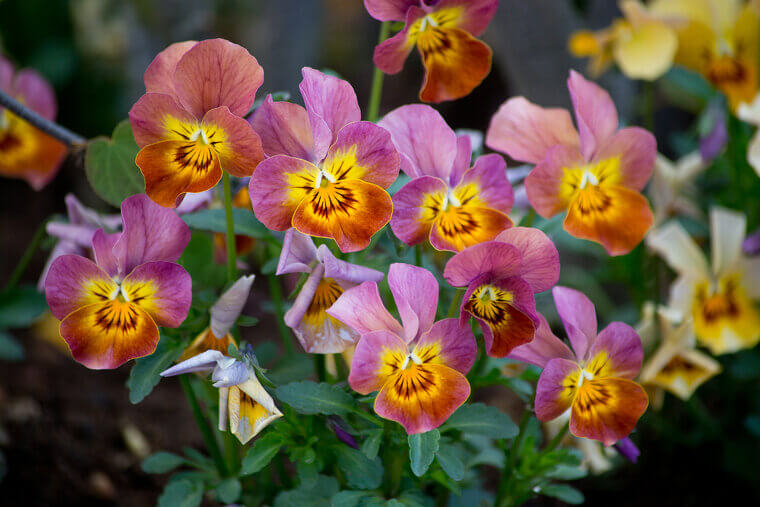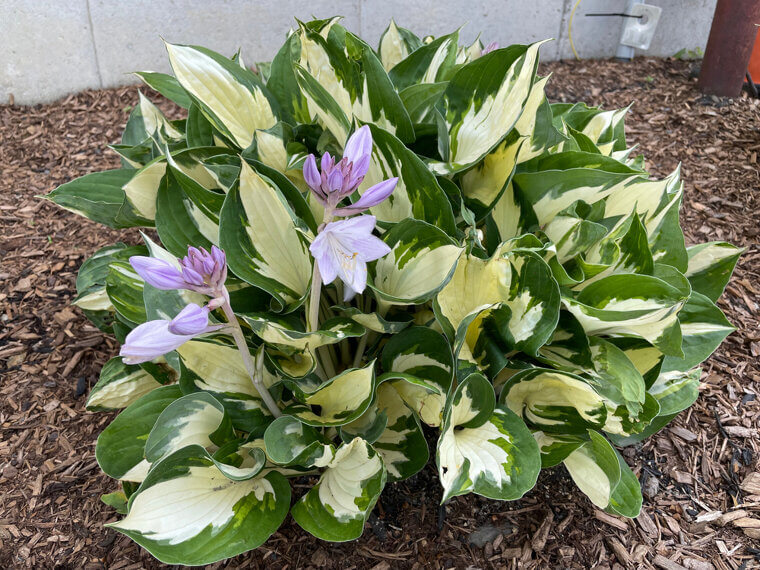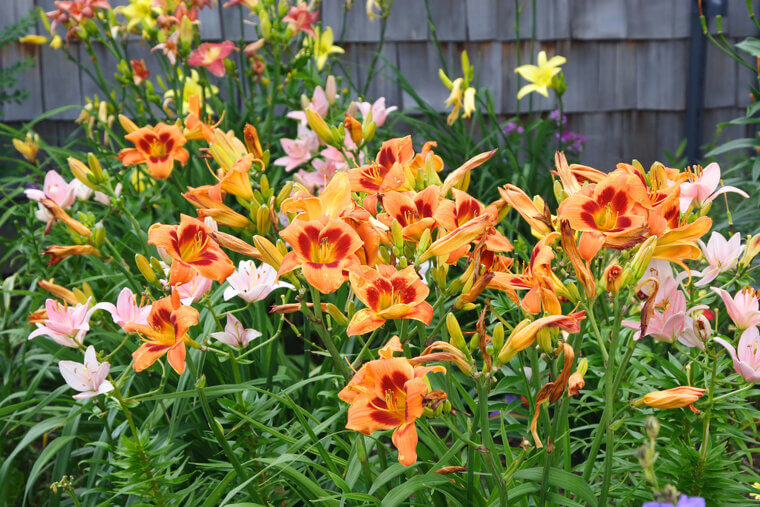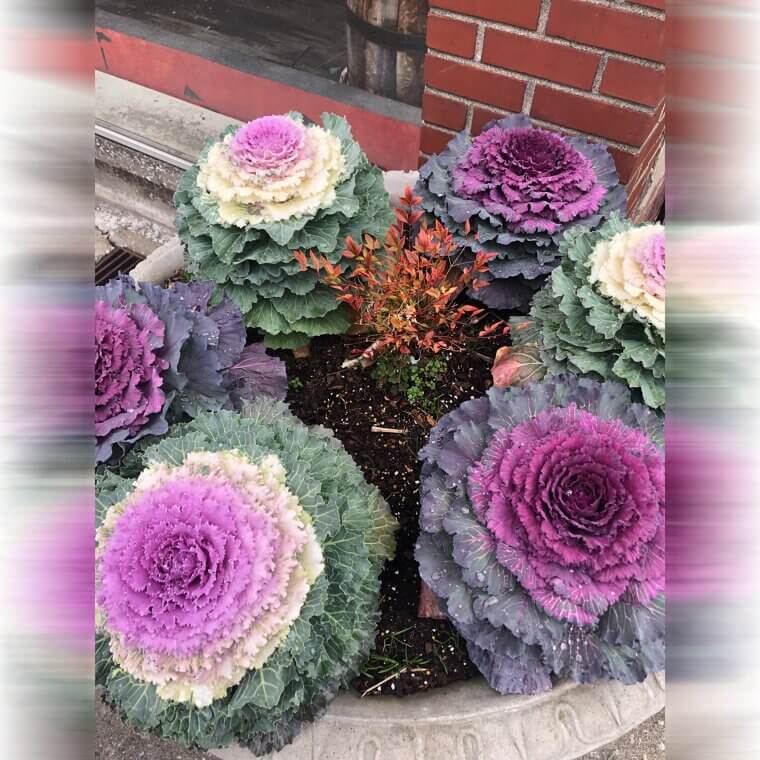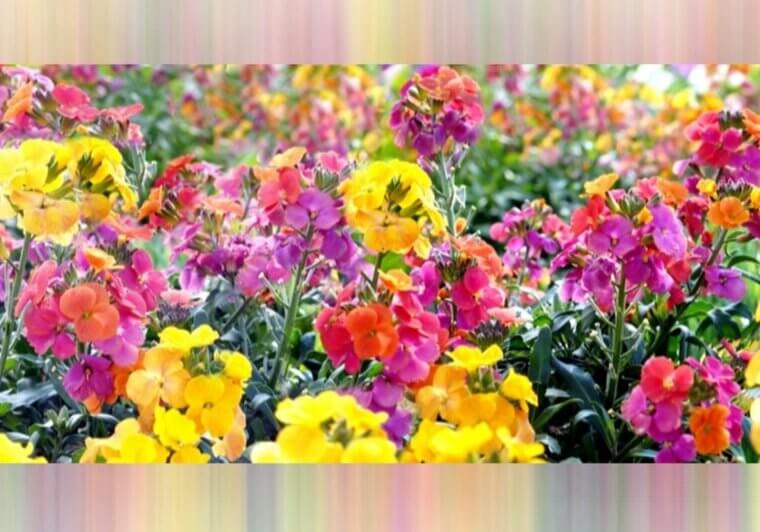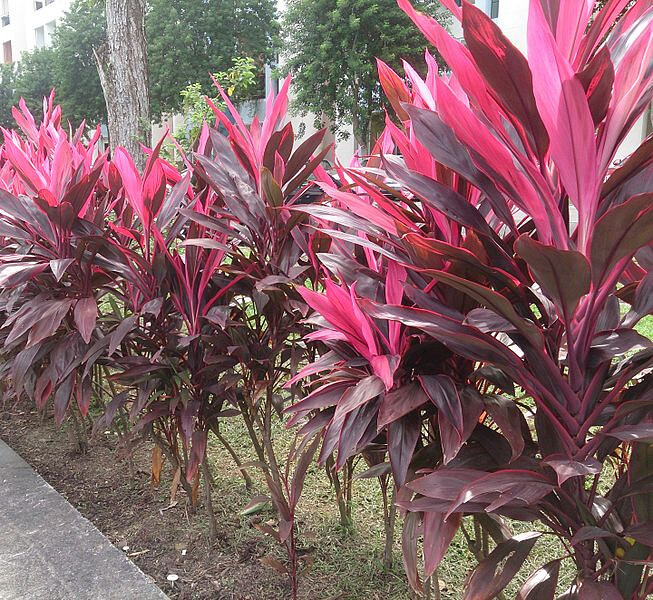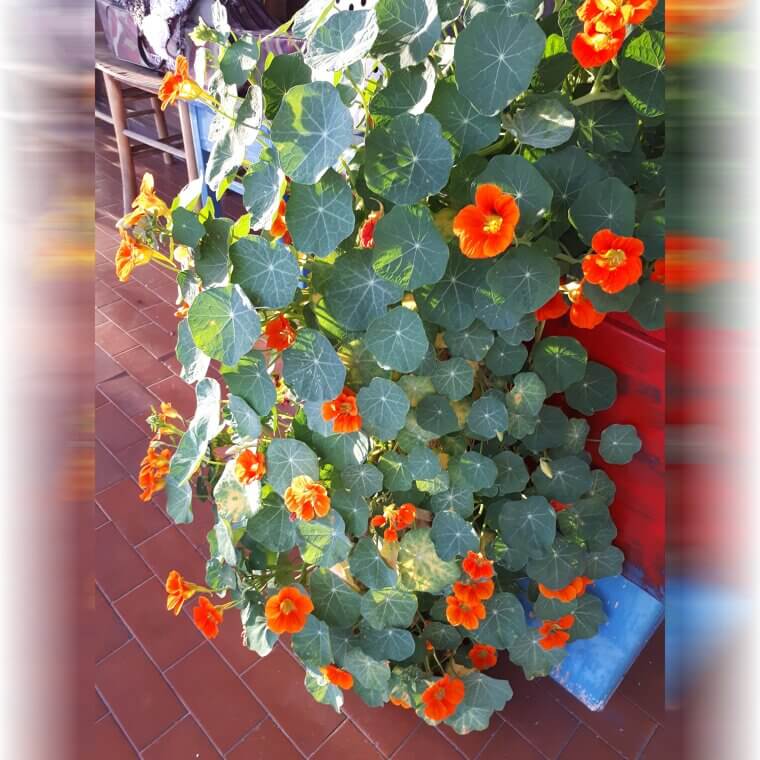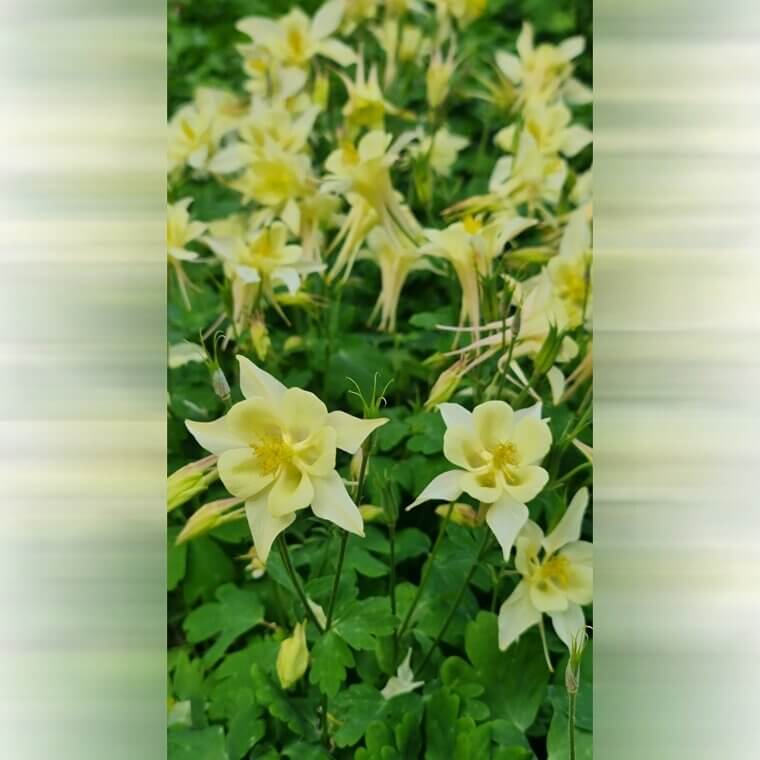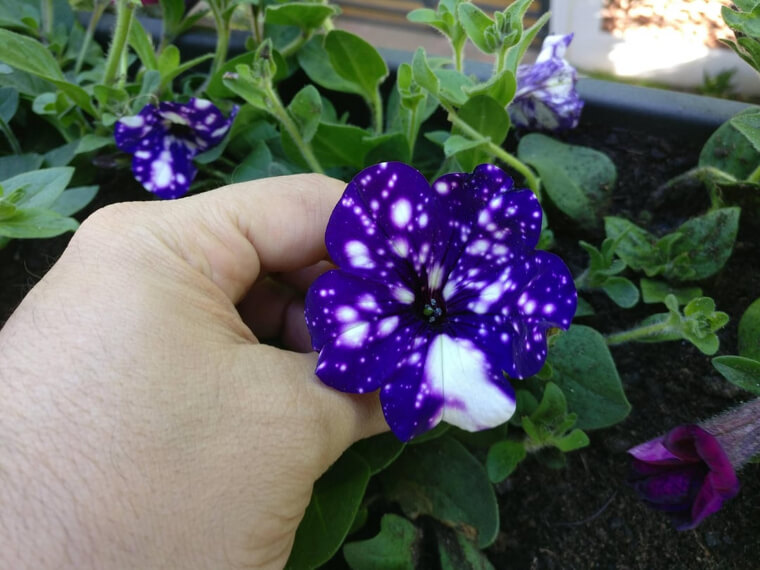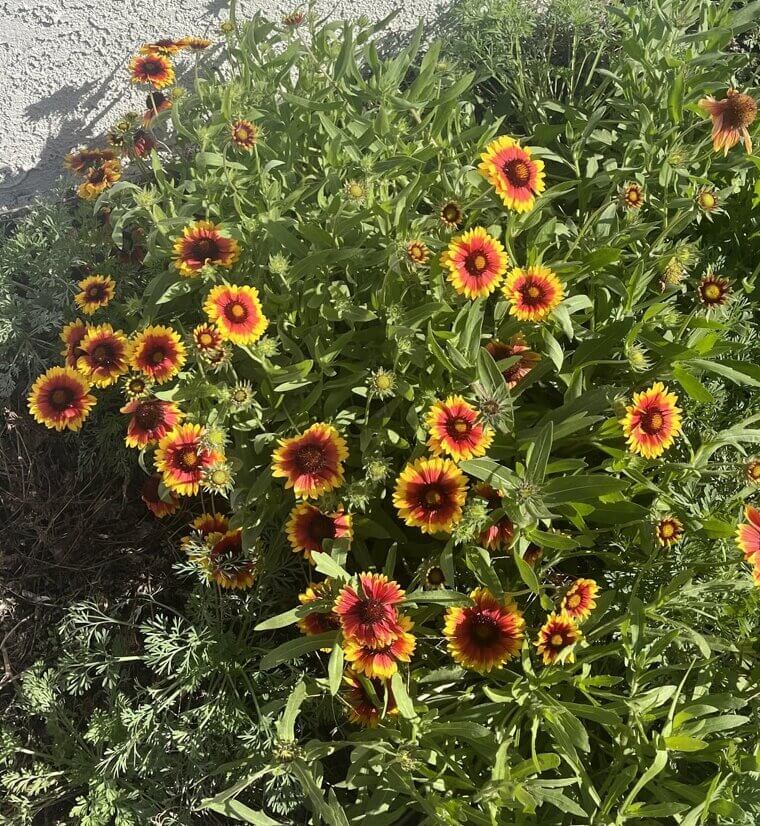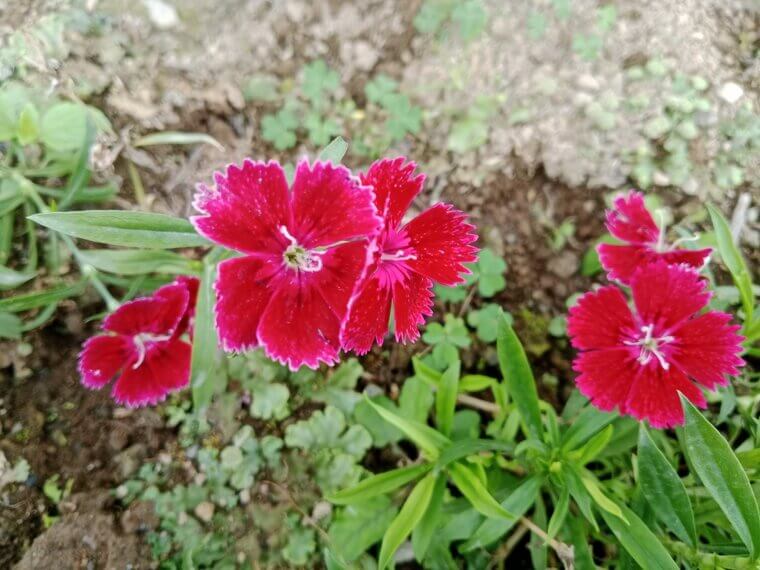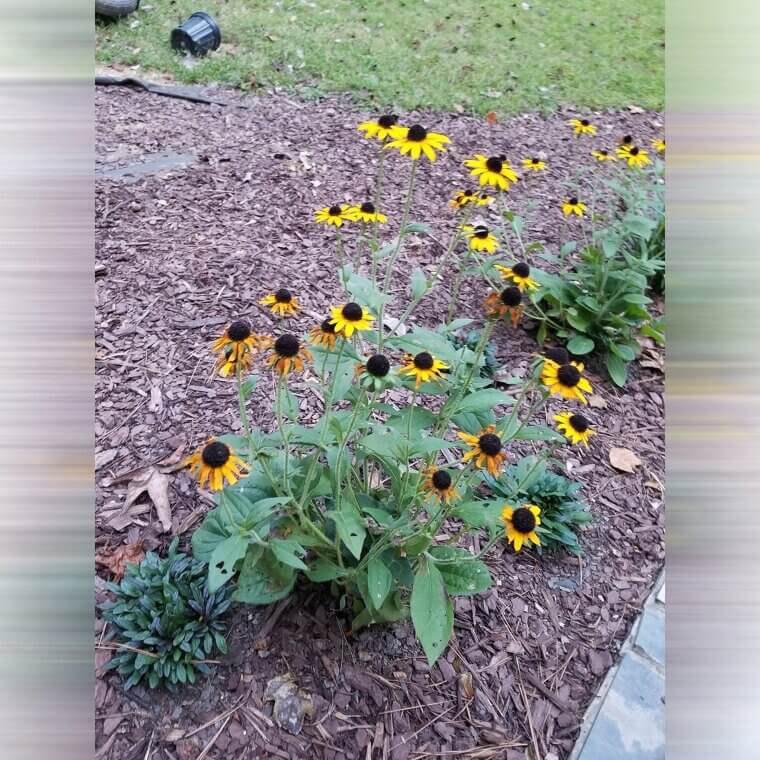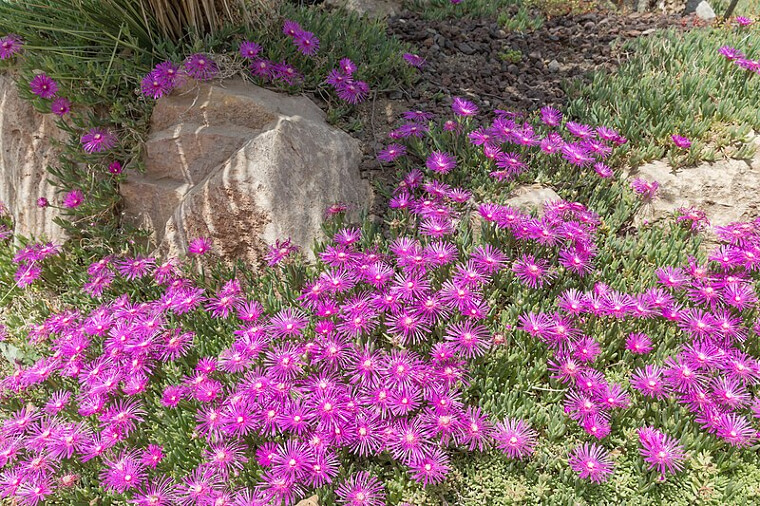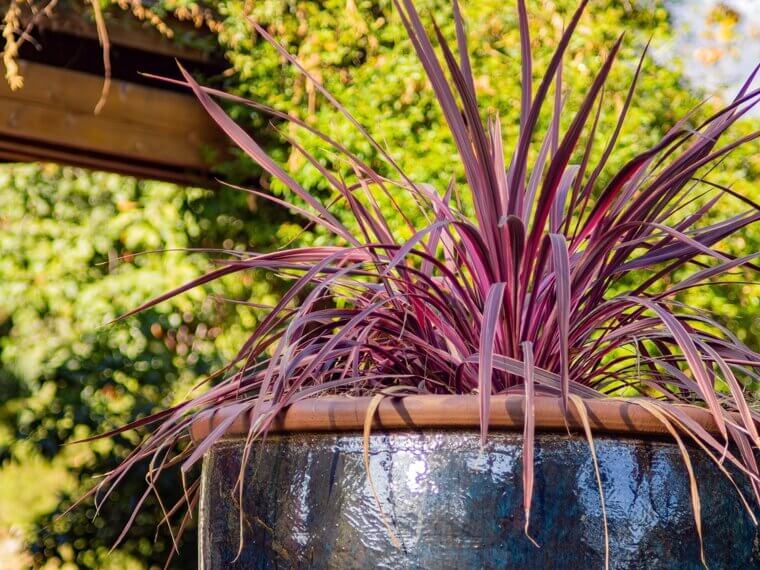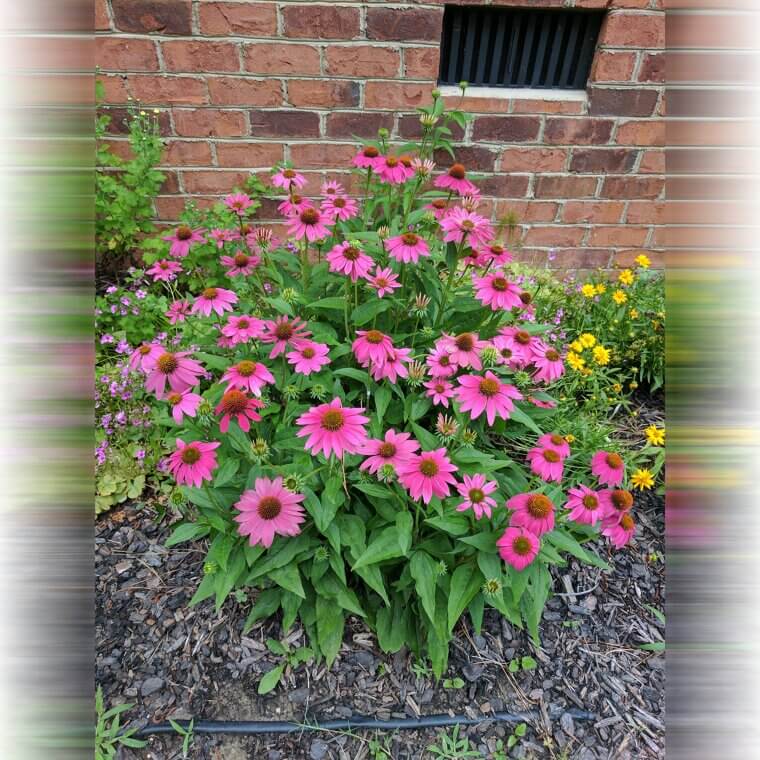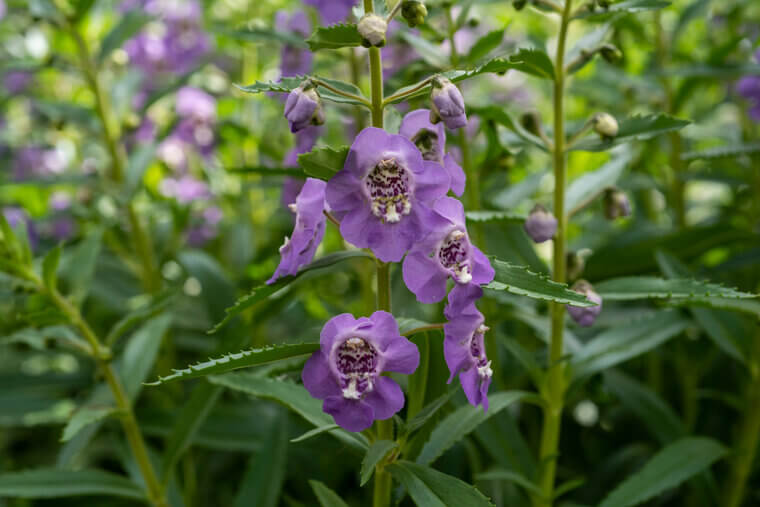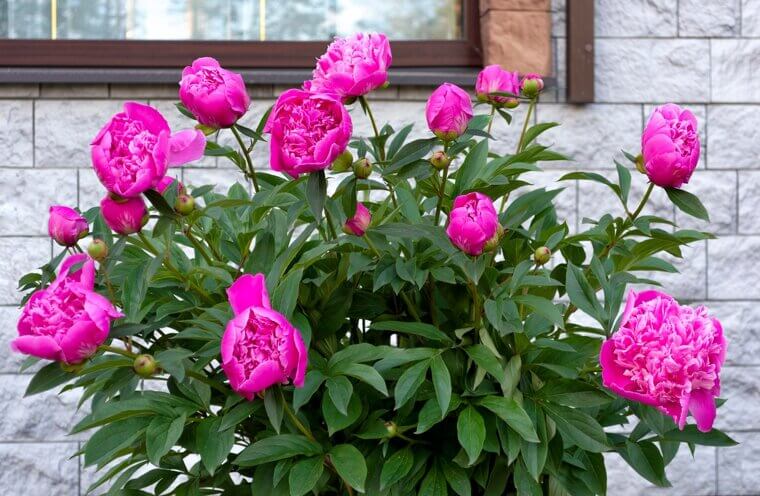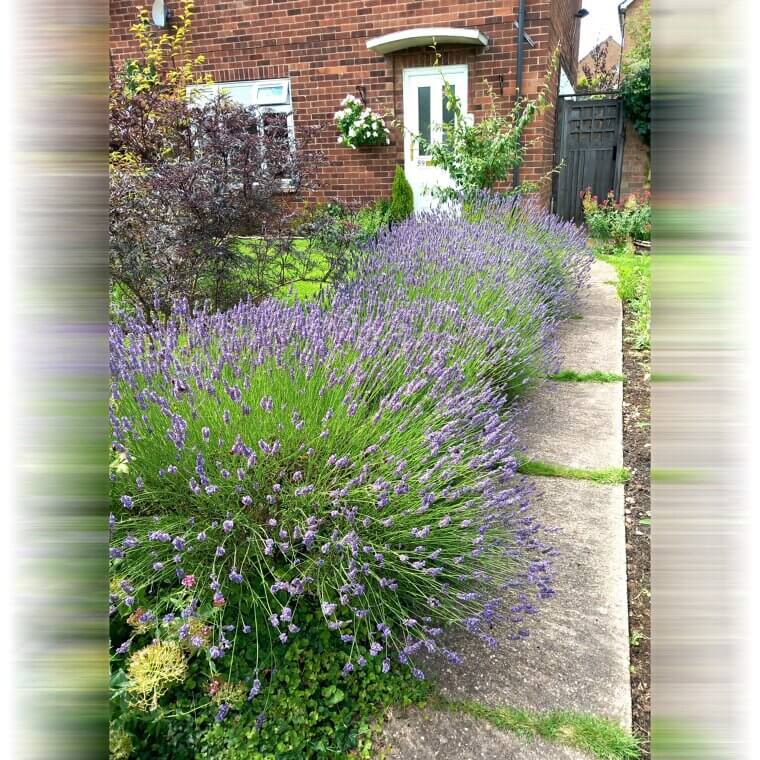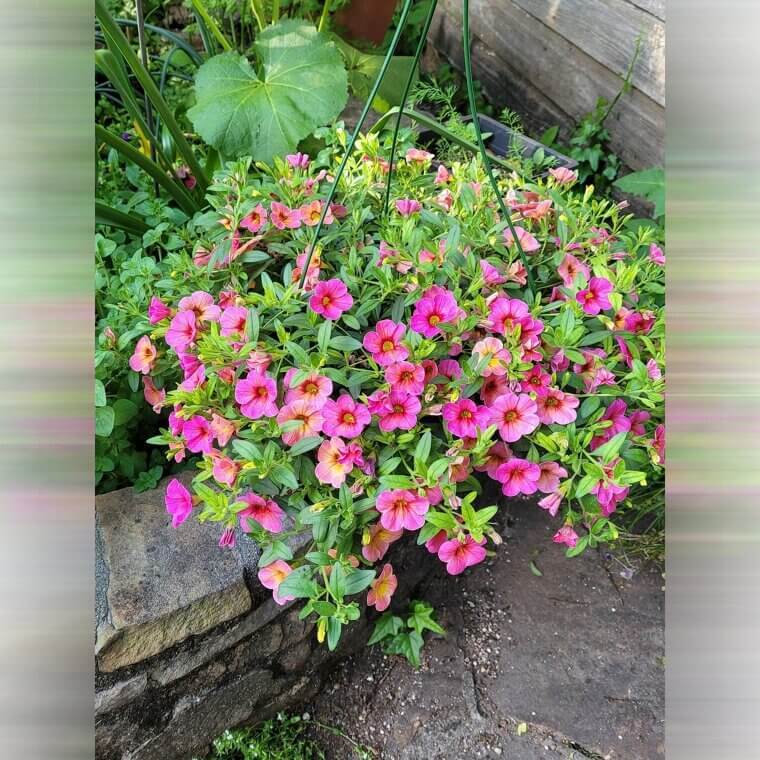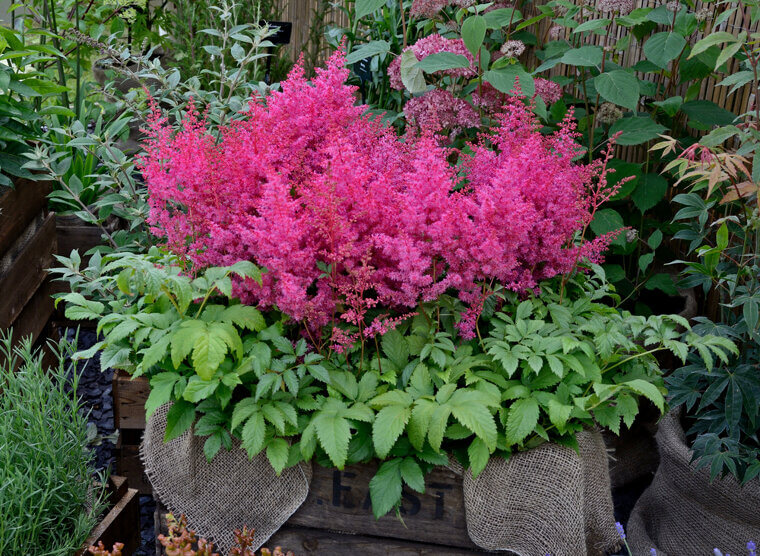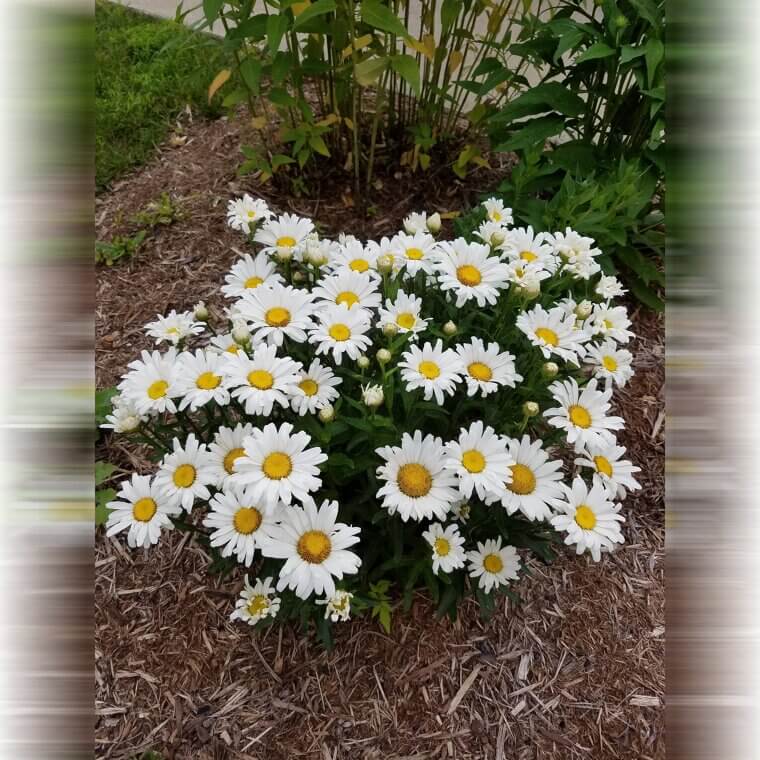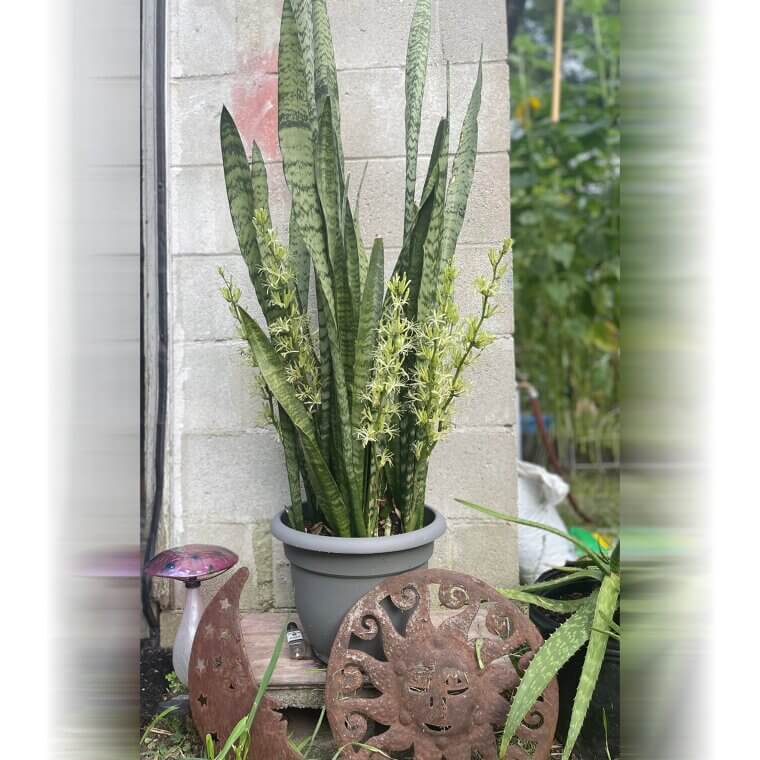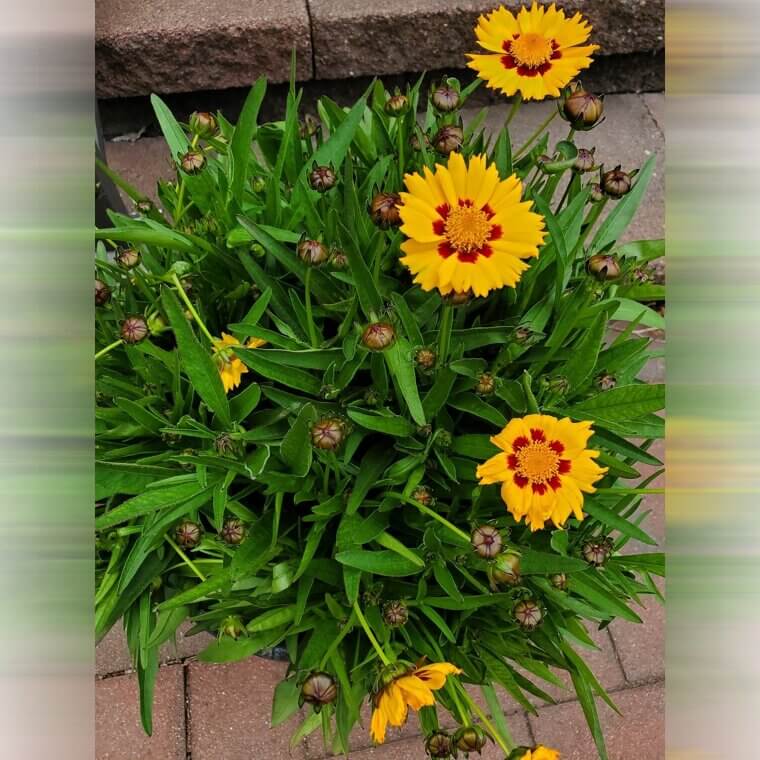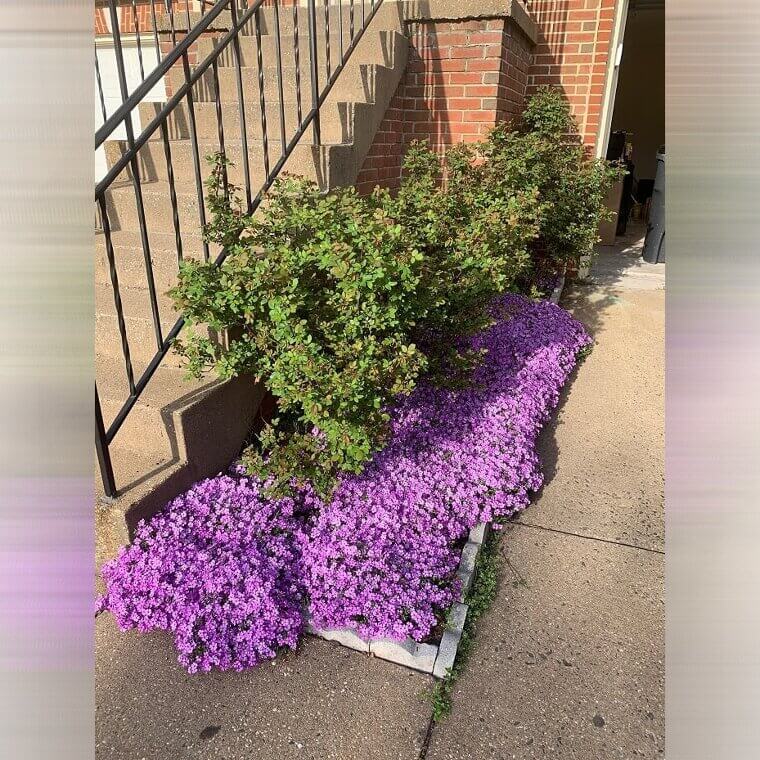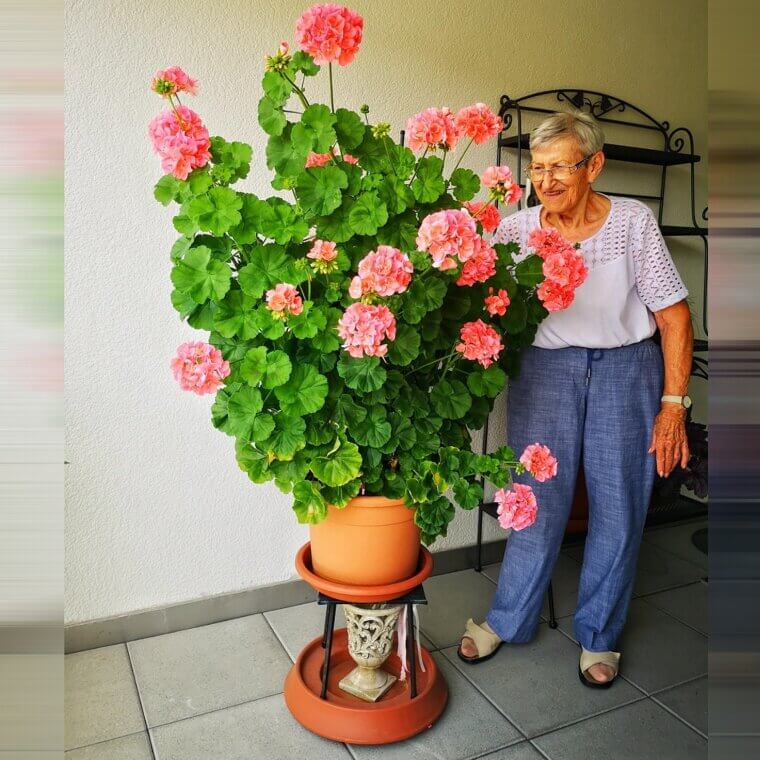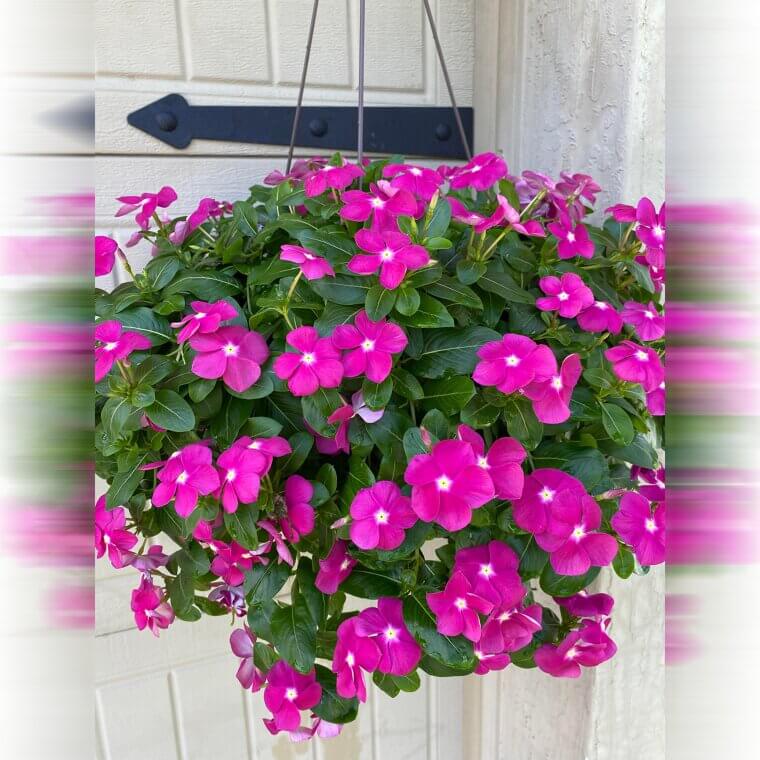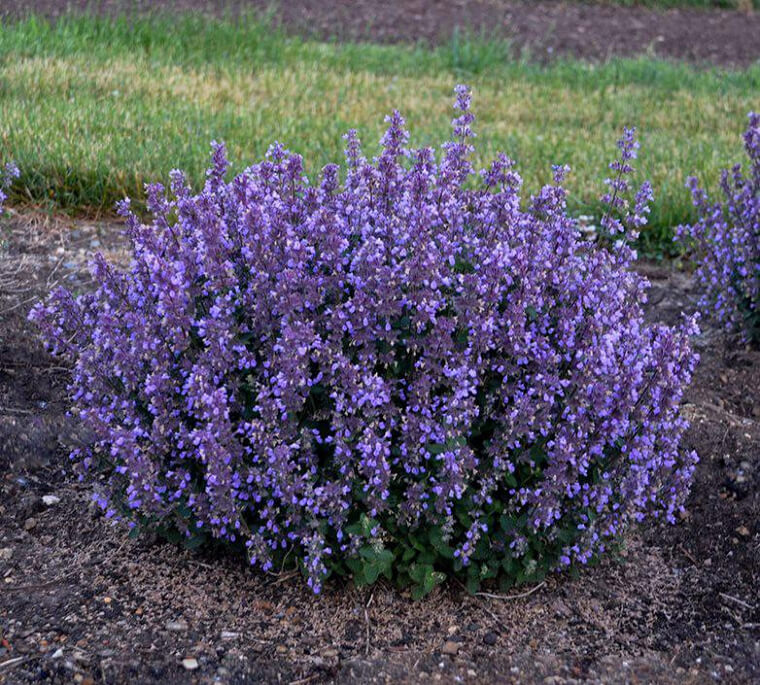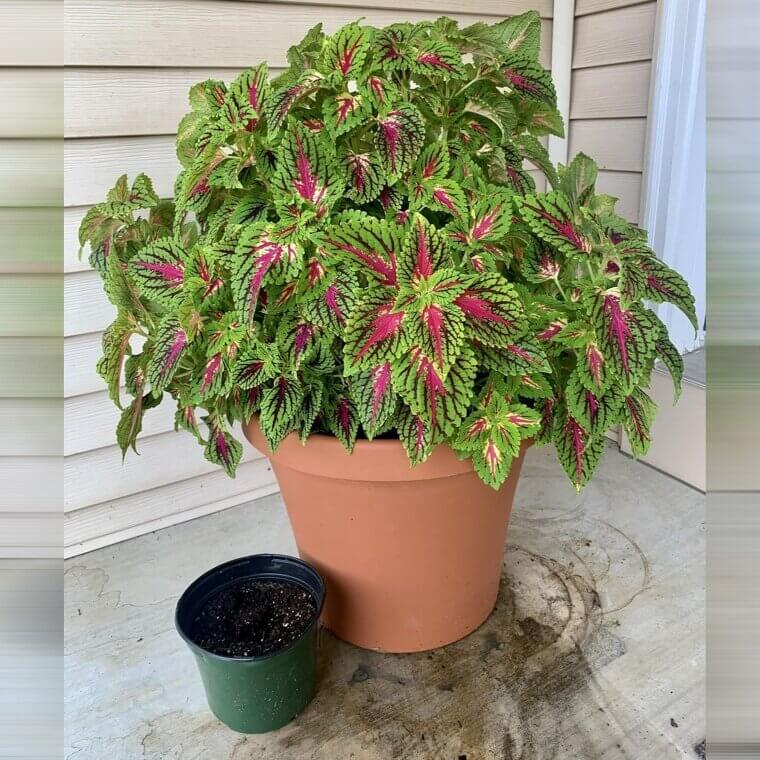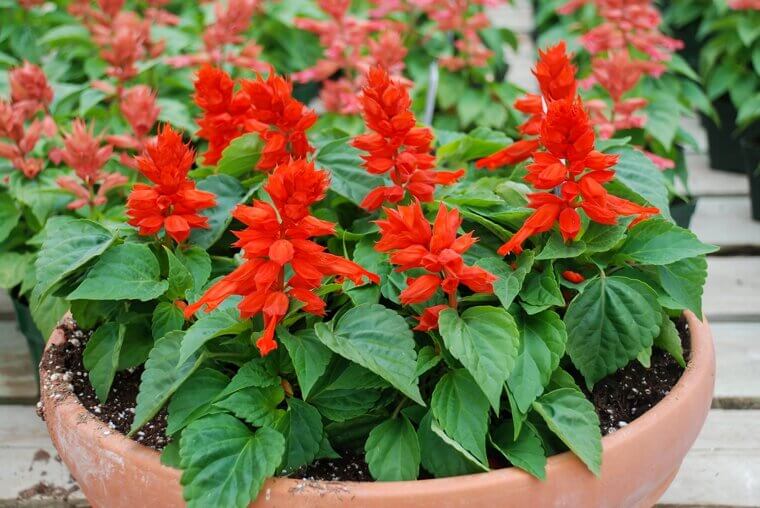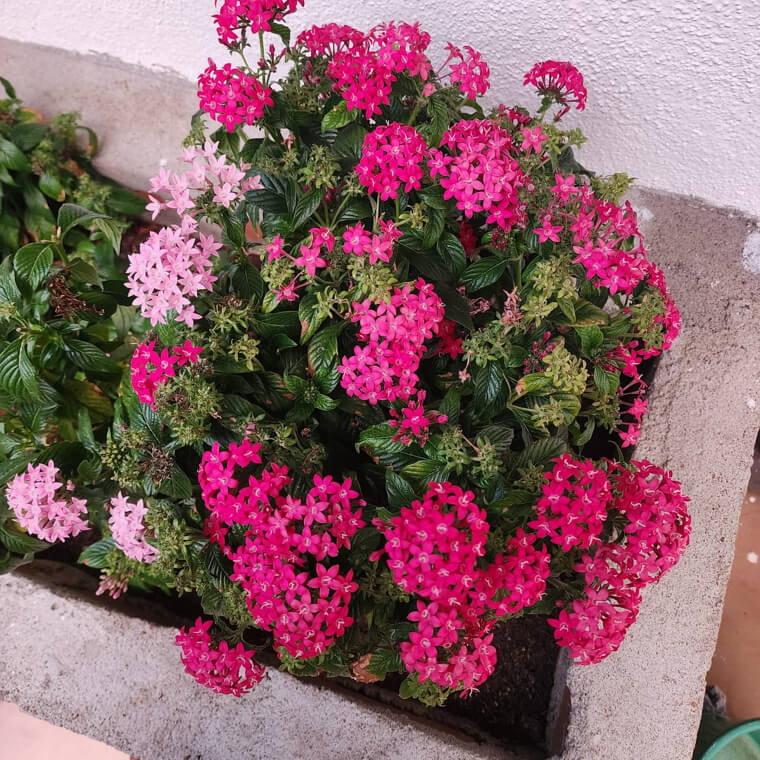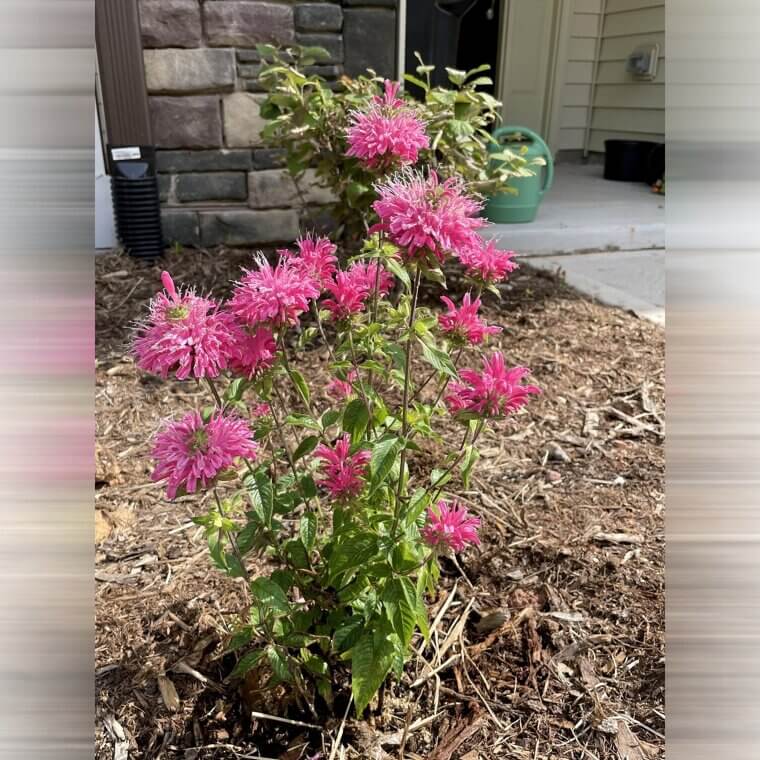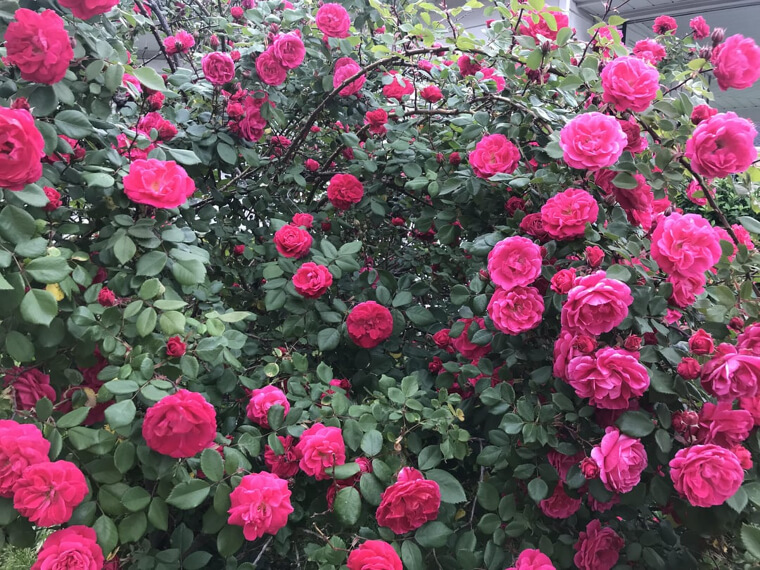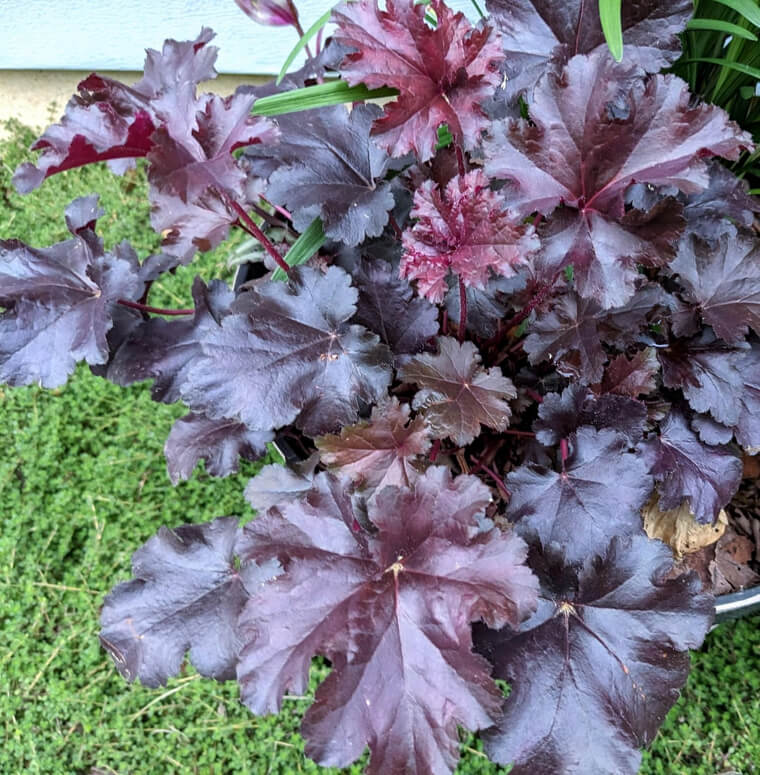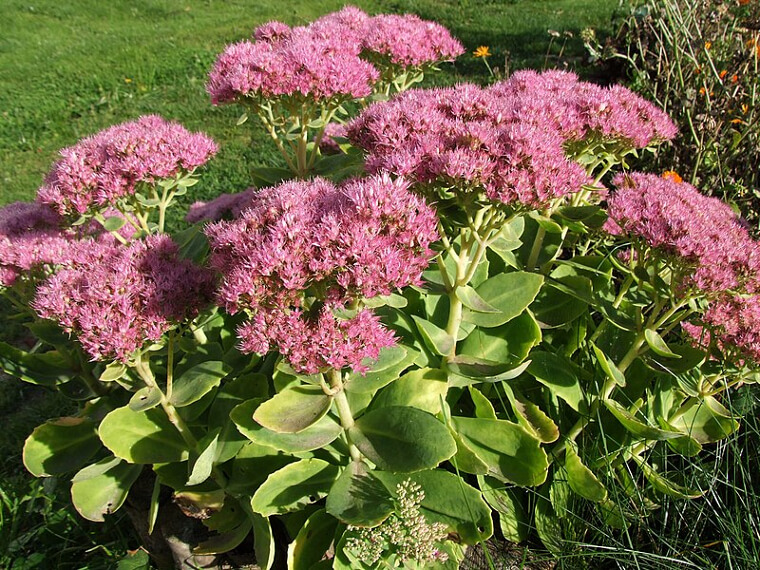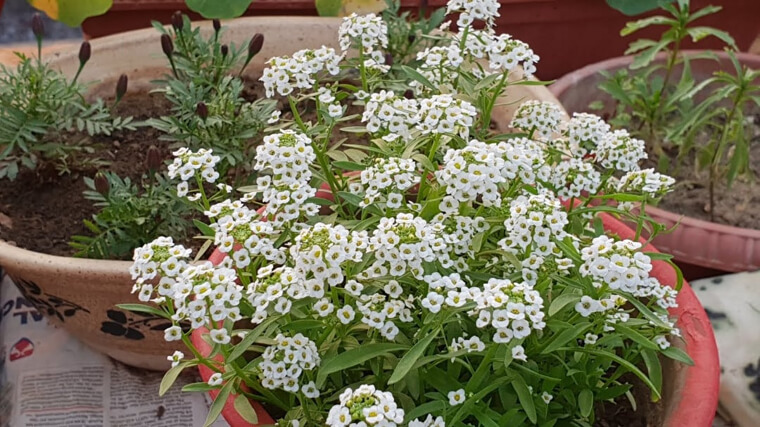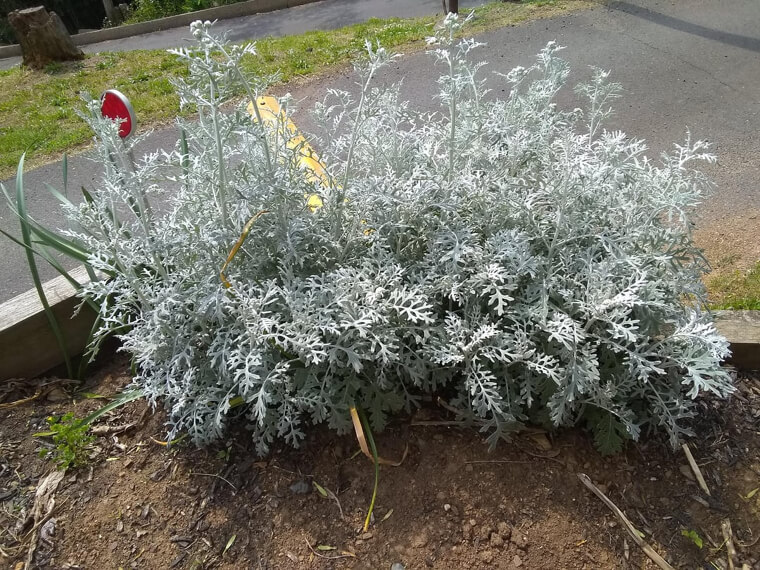Yarrow
Yarrow has been a common fixture in many gardens, known for its simple beauty that comes in a variety of colors. Many are partial to the classic white, yellow, and red as popular options to add splashes of vibrance to greenery with these bushy flowers. It also has an interesting bit of mythological history, making it great as a conversation starter when people come looking, as it's said that Achilles used yarrow to help his fellow soldiers after battle, leading to their legendary resistance.
When handling yarrow, be sure to wear gardening gloves. It has been known to cause photodermatitis, a skin reaction that causes skin to break out and itch in light. It's also quite hardy when kept in well-drained soil and given full sun.
Switchgrass
This deep-rooted plant comes out of the American prairie and is a perfect fit for something resilient to the change of season. Its tall fronds dance in the wind and can give your garden a beautiful splash of texture and movement, evocative of the open plains that switchgrass calls home. Not only will it bring exciting texture, but the deep-rooting nature is excellent for preventing erosion in the soil, improving overall soil health for other plants it shares a space with.
Switchgrass needs full sun and well-drained soil to stay optimally healthy. It's surprisingly low-maintenance in these conditions and will greatly support your garden's ecosystem.
Pansies
The hybrid pansy is another quintessential flower that avid botanists and florists should know well. These symbols of cheer and whimsy are renowned for their expressive, kaleidoscopic blooms that group in small explosions of color. However, not many realize that they are just as resilient, thriving in the cooler parts of the year as opposed to the warmer months like other flowers. Pansies will remain a staple fixture for year-long vibrancy. Like many plants on this list, pansies like well-drained soil.
They also prefer full to partial sun and cooler temperatures. Mulch is recommended to keep the roots cool and moist, and deadheading ensures consistent flowering.
Hosta
The elegant hosta is renowned for its versatility and adaptability to various environments. It flourishes even in dim areas such as around the bases of trees, north-facing walls, or less sunny climates. Hostas have large, vibrant leaves that come in a variety of colors. Classic green alongside blue, chartreuse, and white leaves lets you get creative with their placement. They are also known as plantain lilies, and their unique texture adds extra depth to your garden design.
Optimal growth requires well-drained soil and a layer of mulch for moisture and to combat weeds. They can also grow quite dense, strangling themselves in poor conditions. Dividing their bulbs in the spring or fall will help manage this.
Daylilies
These charming flowers are quite popular among gardeners for their thick-petaled flowers, which are quite the show. Daylilies have a very brief but spectacular flowering period, during which they bloom quickly and then begin to die off quickly. Most flowers will typically last only a day, though clusters will continue to bloom over several days. The remaining spiked greenery can be quite fetching even once they've flowered and shown off their white and red flowers.
Daylilies prefer well-drained soil and full sun, though they will likely thrive regardless of the optimal conditions. However, they are quite toxic to cats, so outdoor cat owners should pick a different all-year plant.
Ornamental Kale
Ornamental kale is a unique option for those looking for something more eccentric. A cool-season plant that truly shines when the temperatures begin to drop in the fall and early winter, they're an excellent option for adding unique texture and color to your winter garden. This is because of their bold rosette leaves that cascade downward in a series of levels, with the leaves being bold shades of green, purple, pink, and white.
Organic compost, full to partial sun, and well-drained soil will keep the kale in good condition. As it is kale, the leaves are actually edible and can make for beautiful splashes of color in wintery dishes.
Wallflowers
These spring bloomers are an option for someone looking for another seasonal clock, as they are a herald of the season. Blooming with bursts of rich, warm colors such as yellow, orange, and red, they also boast one of the more unique aromas: a pleasant combination of sweet and spicy. However, Their vibrant blooms tend to suffer in the winter, and they will need some additional care and observation to ensure they don't suffer from the frost.
To help with their wintery weakness, mulch around the base of the plant can keep it moist and warm, and deadheading spent blooms prevent unwanted wilting and rotting.
Ti Plant
The Ti Plant can change up the feeling of any garden, given its rather unique appearance and coloring. The large plant has long, bright red leaves that darken closer to the stem, adding a tropical feeling to any garden. Given its tropical forest origins, it's also incredibly adaptable, readily flourishing in any lighting condition. These exotic plants also are surprisingly low-maintenance, making them an easy inclusion regardless of the gardener's caliber.
The biggest thing to remember is that the vibrancy depends on the richness of the soil. Organically enriched soil and good drainage will help these plants maintain their roots and prevent rot.
Monk's Cress
This flowering plant, also known as nasturtium, is well-known in the culinary, botany, and floral worlds. The vibrant colors of the flowers, which range from reds to yellows, stand out from the rich green leaves and stems they grow from. The plant originally comes from South America, where it's widely used and beloved for its peppery flavor in a variety of dishes. It's also easily cultivated, making it a great annual event for spicing up some homemade cooking.
Monk's Cress thrives in various lighting conditions, from shade to full sun, but it prefers less rich, slightly acidic, and well-drained soil. It uniquely prefers moist, infertile soil.
Aquilegia McKana Giants Mix
A member of the columbine family of plants, the Aquilegia McKana Giants Mix has a mouthful of a name to match its uniquely delightful and whimsical appearance. The flowers are large and spectacular, showing in shades of blue, pink, and yellow, with a unique spurred shape that makes them appear as though they come out of some fairytale. These flowers also prefer shaded areas and cooler temperatures, thriving in temperate gardens filled with butterflies and hummingbirds, which are their classic pollinators.
Moist, well-drained soil, and partial shade to protect these flowers from too much sun will keep them fresh and vibrant. They fit best in woodland gardens that benefit from tall trees and bushes.
Surfinia
Surfinias are dazzlingly vigorous members of the Petunia family. They can quickly spread and grow large bushes that protrude with flowers when in bloom. These plants are favorites in hanging baskets, window boxes, and planters, as their bold colors can easily be cultivated for lush displays. They also happen to thrive in various climates where there is plenty of sun and are lush from spring to fall, with the greenery becoming prominent in winter.
Well-drained soil and regular watering to ensure surfinia is moist but not waterlogged is vital. It can be pretty sensitive to too much water, causing the plant to become too heavy and damage itself. Deadheading is also encouraged.
Blanket Flower
Blanket flowers are popular in the southwestern regions, often incorporated into patterns and textiles of the area's indigenous people. They are also praised for their resilience, ease of care, and bright orange, red, and yellow blooms that last a surprisingly long time. The bright colors are accentuated by the thick, dense, deep green foliage that enshrouds the flowers, evoking the image of a sleepy sunset. Blanket flowers require full sun and well-drained soil to thrive.
Otherwise, they risk root rot and rapid wilting after they bloom. When properly cared for or in their natural habitat, blanket flowers can remain in bursts of color throughout the entire year.
Pretty Poppers Electric Red
This variety of ornamental pepper has earned its "electric red" title quite well. It is most often chosen for its bright red, bulbous fruits and flowers that stand out against the dark green foliage that it grows from. Growing equally well in garden beds and planters, the peppers are edible, though they make great texture pieces to add to your flower garden, as the fruits have a more intense color than the flower itself.
The Pretty Poppers Electric Red thrives in warm conditions and needs regular watering, full sun, and well-drained soil. Gloves are also recommended when handling the peppers to prevent any spicy mishaps.
Black Eyed Susan
Related to other coneflowers, the Black Eyed Susan stands out amongst its cousins for its exceptionally vibrant yellow petals, which are contrasted by the dark, near-black cone centers that give the flower its name. These flowers are a perfect fit for more summery-themed gardens and carry the connotations of cheer and fun in the sun. They are also easy to take care of and are surprisingly drought-resistant for areas with plenty of sun but less water to go around for the garden.
Like other coneflowers, Black Eyed Susan prefers well-lit, sunny areas with well-drained soil. This is perfect for summery themes, especially as the yellow color is known to attract pollinators.
Ice Plant
The ice plant is similar to sedums and succulents, offering a vibrant purple alternative that is perfect for sweeping ground covers. These flowers are great for warmer climates, as they are remarkably resilient to heat and drought conditions, and their flowers are pretty long-lasting. This makes them popular among gardeners who want something low-maintenance and in hot climates. The long bloom period also ensures there will be some color throughout the garden.
Full sun and well-draining soil prevent root rot and will maximize the iconic bloom that gives the signature sweeping ground cover. They also happen to fit well amongst rock gardens and slopes, given their resilience and preferred climates.
New Zealand Flax
The sword-shaped leaves of the New Zealand flax add to the dramatic presence that fans love about the plant. Not only are the leaves bold and striking, but they come in green, bronze, and rusty colors, further adding to the comparison of this perennial. The foliage can easily grow as tall as a person, or possibly taller, and is widely adaptable to a variety of climates and lighting conditions. It's also attractive to a variety of pollinators seeking shelter.
Well-drained soil and ample space are crucial to cultivating New Zealand flax. Once properly established, it requires minimal maintenance and is freely growing on its own. The plant also thrives best in coastal climates.
Coneflower
These vibrant flowers are well known for their striking purple and red blooms. They're also known for their robustness, which makes them the perfect option for a garden that wants to thrive all year long. Resistant to intense heat and sunlight and requiring little water, these flowers are perfect for warmer climates. They're also quite popular in various herbal remedies, and the seeds are easy to collect during the winter.
Coneflowers need sunnier spots and well-drained soil to reach peak vibrancy. They're popular with pollinators, making your garden feel alive and abuzz. Deadheading the flowers will keep the color throughout the year.
Angelonia
Also called the "Summer Snapdragon," Angelonia is often confused with the actual Snapdragon flower, despite some differences. These flowers are perfect for sweeping ground-cover garden beds, blooming in tall blue, pink, white, and purple spikes. They come to life under the sun and thrive in the heat. In fact, these flowers are perfect for places that experience intense heat, as they are incredibly drought-resistant and can protect the soil in these harsh conditions.
Angelonias need to be planted in low, flat, sunny areas, giving them plenty of room to sprout upwards. These flowers are great for adding height to gardens, creating a variance in the topography.
Peony
Despite their brief blooming period, peonies are luxuriously low-maintenance flowers perfect for celebrations. These strikingly colorful flowers are popular for all kinds of celebrations, like anniversaries and weddings. In fact, they are a favorite to many people around the world. Peonies also have a uniquely special relationship with ants, as the insects seemingly flock to them and act like unusual pollinators, making these flowers even more of a unique addition to the garden.
Well-drained soil and full to partial sun will keep these flowers healthy when their annual bloom occurs, allowing the full spectacle to unfold.
Lavender
An iconic flower with an easily recognizable color, texture, and scent, lavender is famous for a reason. These herbs are incredibly resilient and are a classic garden element to include for something more calming. The variety of lavender found throughout the US is typically hardy enough to endure throughout the colder winters, where the color truly pops and the scent is sharper. It's also great for cooking, herbal remedies, and a natural perfume.
Full sun ensures the lavender remains robust and hardy enough to survive harsher conditions and thrive in sunnier conditions. Well-drained soil also allows for more abundant and thicker growth.
Million Bells
The beautiful flowers of the Million Bells are a stunning addition to anyone looking to create a cascading effect. These petite flowers are similar in shape to petunias and come in various colors, often on the same plant. It isn't uncommon for a single plant to bloom in orange, yellow, blue, red, and purple, creating its own bouquet of sorts. They also bloom throughout the entirety of spring through to fall, with the green spikes offering a different look for the winter.
Million Bells requires full sun and well-drained soil to flourish properly. They will also require regular deadheading to encourage long-lasting blooming. They are ideal for hanging baskets and containers.
Astilbe
The astilbe plant is perfect for those looking for a shaded garden that will still thrive around the clock. Its bright red and purple color and feathery plumes of flowers are stunning and striking alongside the other flowers one might typically find in the shade, making them great contrasting centerpieces. Its propensity to thrive in shaded lighting is excellent, and its easy-to-maintain nature makes it perfect for bringing a patch of shade to light.
Moist, well-drained soil is all the astilbe needs to thrive. Organic matter can further enrich the soil and help make the color pop in low lighting.
Shasta Daisy
The Shasta Daisy is one of those flowers that epitomizes summertime. These flowers are the classic white-petaled, yellow-centered daisy that everyone thinks of when thinking of the classic daisy. It is excellent as they double as resilient to dry, harsh conditions during hotter summers. Where others may wilt in summer, these flowers only shine more, and they also have a pleasant aroma that's easily picked up by the breeze.
Full to partial sun and well-drained soil are all that's needed, though one has to be careful with the specific quality. Shasta Daisies spread like wildfire, so deadheading will be required to prevent them from spreading too fast and too far.
Snake Plant
Also coyly known as the Mother-in-Law's Tongue, the snake plant is known for its hallmark stiff, upright leaves. The leaves feature sharp edges that come to a point, with a green and yellow pattern that has earned them a few comparisons to swords. These are great plants for someone looking for something low-maintenance, as they tolerate low-light conditions and infrequent watering. Coupled with their air-purifying qualities, the snake plant is excellent for indoor gardens.
Preferably, you'll want to plant these in a well-draining potting mix and monitor the soil, as it will only need watering once the soil has completely dried out.
Coreopsis
A North American native flower, Coreopsis is perhaps better known as Tickseed. These bright yellow and white wildflowers can be seen in meadows across America in daisy-like patches and clusters. They are pretty charming and dainty and should be handled delicately by people. Against the elements, however, it can be surprisingly resilient to harsher weather conditions and offer a cheerful option for those who want a sweeping landscape of color.
Once again, full sun and well-drained soil are your best friends here. Thankfully, tickseed is quite low-maintenance in these conditions and will also attract pollinators on its own when healthy.
Creeping Phlox
Creeping phlox is a hardy, beautiful option for those looking for a ground-cover option that thrives in colder climates. Native across the Northern Hemisphere, all the way from North America to Siberia, these flowers blanket the grounds of forests and fields with a cascade of purple, pink, and blue. True to its name, it spreads quickly and reaches into any cracks and crevices in the ground, creating an impression of the ground it's rooted in across the blanket of flowers.
Full to partial sun and well-drained soil will encourage the flowers to stay in bloom as long as possible. Blooming in the early spring, these flowers are perfect for acting as the seasonal clock in your garden.
Geranium
Geraniums are beloved flowers for their vibrancy in the face of adversity. These flowers are remarkably hardy in nature and a staple of gardens around the world. They also come in a variety of different colors and are quite aromatic, with their particular scent deterring many common garden pests. They are also quite easy to grow and suit a variety of different garden styles. Overall, geraniums are quite gardener-friendly and are both beautiful and practical.
Geraniums require regular watering and full sun for most of the day, though care must be taken not to overwater them. Waiting until the soil is slightly dry is a good indicator that it is time for watering.
Cora Vinca
More commonly known as the periwinkle, cora vinca is another plant that can survive in the intense heat of the always-sunny parts of the world. Where other flowers might wilt in the heat, periwinkles shine, with their broad spectrum of colors becoming more vibrant as the temperatures rise. Their glossy dark green leaves are always quite popular when the flowers aren't in bloom, offering a deep, rich, natural tone to the garden, especially when placed in rock gardens.
These plants need well-drained soil, full sun, and regular watering to maintain their deep, vibrant coloring. However, they will otherwise need little maintenance and bloom on their own well enough.
Catmint
While our cats might be more a fan of the infamous catnip, catmint is the calmer version that you might prefer if you aren't so keen on attracting every cat in the neighborhood. This version instead attracts bees and butterflies to help pollinate the rest of your garden, blooming profusely throughout the season, giving you properly deadhead the ends. Catmint can quickly become a favorite option with some care, offering a soft sprig of silver-gray foliage and purple flowers.
Catmint prefers partial sun most of the time, though it thrives under full sun. Well-drained soil makes maintenance easy, and it forms a fragrant hedge or garden bush.
Coleus
The coleus plant is well-known and beloved for its dazzling vibrancy, standing out no matter the garden setting. This all comes from its beautiful leaves, which are all the colors that can be found in shades of red, yellow, pink, orange, purple, and classic green. Not only is the color vibrant, but the flowers also often exhibit a two-tone pattern that creates a further contrast, making these a showstopper of note.
The key to coleus plants is to experiment. These versatile plants thrive in all lighting conditions and soil quality, so the most important thing is to choose which plants to pair them with.
Salvia
A member of the mint family, Salvia is an eye-catching sage-like leaf that flowers in bright, deep reds, blues, whites, and oranges. This makes it quite popular for Fourth of July celebrations across the States. Salvia is also a practical plant for making a resilient garden, as it requires minimal care to thrive while deterring deer or similar animals from munching on the leaves. The leaves in question also differ from the usual green, offering a silvery alternative.
Full sun and well-drained soil are best for achieving vibrant colors. Deadheading will also keep the plant continuously flowering, healthy, and vigorous.
Pentas
Pentas is one of the most appropriate names for the flowers in this list. They have peculiarly star-shaped flowers that grow in spherical clusters and are loved by hummingbirds and butterflies. In addition to their unique shape, they have a vibrant color palette of white, pink, red, and purple. Pentas are assured to give any garden a vibrant splash of color and a unique texture that sways in the breeze.
Pentas need well-draining soil and regular watering, as heat is their greatest enemy, and they can be prone to drying out. Slow-release fertilizer and deadheading will keep the blooms balanced and continuous throughout the seasons.
Bee Balm
Bee Balm is an excellent choice for those who are big fans of the idea of a lively garden full of pollinators and bees. Bee Balm is a member of the mint family, and instead of the leafy petals of other flowers on this list, it boasts tubular flowers that come in reds, purples, and pinks. These flowers have a rich history throughout North American history as one of the more essential pollinators in nature. They are synonymous with the wild, thistly imagery we often think of in some parts of The States.
Bee Balm thrives under full or partial sun, perfect for open gardens or nestled among wider trees that offer shade. Well-drained soil will also help keep them healthy and prevent root rot.
China Rose
The beautiful rose is a great option for those who want the classic rose feel but also something more low-maintenance. Originating from East Asia, the China rose has been cultivated for so long that it has contributed to the gene pool of many other varieties of modern roses. These flowers bloom in the classic rose colors of pink, red, yellow, and white, carrying the enchanted, mystical feeling from their late spring bloom to the end of fall.
China roses need at least six hours of full sun a day, well-drained, fertile soil, and regular watering. Rose-specific fertilizer is also recommended to encourage full growth.
Coral Bells
The floral chameleon Coral Bells thrive under any lighting condition and are one of the easiest plants to care for. Their large, beautiful leaves are unique to look at, with bright, light green shades that darken on the spectrum as they approach dark reds and deep, royal purples, often shifting into one another in a breathtaking ombre. In the summer, Coral Bells also produce spiky, delicate flowers that accentuate the leaves well.
You can easily achieve vibrancy through the liberal use of organic composting and good drainage. This also helps prevent the root rot they can sometimes be prone to when planted in poorer soil.
Butterfly Weed
The orange bursts of color that come from the butterfly weed are primarily what makes it attractive to gardeners, as these flowers offer an easily maintained way to add the sometimes rare variety of flowers to the mix. They are also perfect for mixing with other flowers as they are some of the best attractors of pollinators of all varieties and are hardy enough once fully planted and established. However, their hardy nature can be a double-edged sword, as overrich conditions can harm the flower.
Planting in poor to average soil is actually best for the butterfly weed, as it can become stifled in conditions that are too good. It also spreads rather quickly, so appropriate spacing is needed.
Sedum
Succulents are known for their remarkable resilience and ease of maintenance, and the sedum is no different. With its hallmark rubbery leaves, the sedum offers an alternative to the many flowers on this list with its unique texture and patterns. It is also quite resistant to cold temperatures, being found naturally as far north as North Dakota. They're also popular with pollinators, giving another option for a lively garden.
Sedums need full sun and well-drained soil to stay healthy, and they require minimal watering to stay full and vibrant. Succulents are also a low-maintenance option that is great for areas with a scarce water supply.
Speedwell
Also commonly known as Veronica and Gypsyweed, Speedwell is a versatile option that can easily cater to various garden styles. It will require some care as it can easily become a dangerously invasive species, given its penchant to spread rapidly. But when curated, it can be a beautiful display that can be shaped into a sweeping ground cover or floral spikes between other growths. Speedwell comes in shades of blue, purple, and pink, making them an easy addition.
Full to partial sun and well-drained soil are necessary for this perennial flower, which requires minimal care on its own. Just beware of the variety you choose to plant; aggressive, invasive varieties can easily get out of hand.
Sweet Alyssum
This charming option is great for those looking for an aromatic ground cover. Sweet alyssum has a wonderful honey scent that is popular among the bees it attracts to pollinate it, and comes in a variety of vibrant shades, such as purple, yellow, and pink. It also prefers cooler climates with temperature weather, where it happens to grow and spread quickly and have a long blooming season from early spring to late fall.
Sweet alyssum enjoys full sun to partial shade and well-drained soil, but it requires regular watering. Dry periods can harm these plants, and they will also require frequent trimming to encourage density.
Dusty Miller
Dusty Miller's name is well earned as this strikingly beautiful plant perfectly contrasts almost anything you could have in your garden. The silvery-gray foliage is stunning, especially considering the finely textured leaves that add extra texture to your garden. These are popular amongst gardeners for their ability to add a surprising amount of depth and contrast when paired with something more flat or vibrant, as well as their year-round consistency when in their preferred milder climate.
Loose, well-draining soil is a requirement for the Dusty Miller to maintain its unique characteristics. It is best used as a companion piece to make its contrasting capabilities truly shine.

